Page 27 of 162
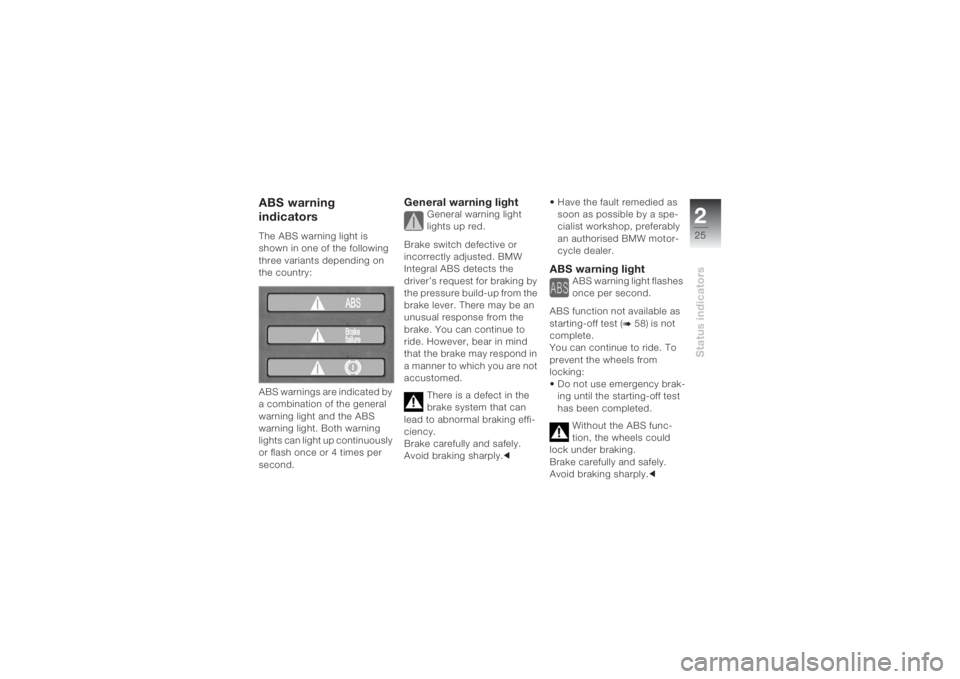
225Status indicators
ABS warning
indicators The ABS warning light is
shown in one of the following
three variants depending on
the country:
ABS warnings are indicated by
a combination of the general
warning light and the ABS
warning light. Both warning
lights can light up continuously
or flash once or 4 times per
second.
General warning light
General warning light
lights up red.
Brake switch defective or
incorrectly adjusted. BMW
Integral ABS detects the
driver’s request for braking by
the pressure build-up from the
brake lever. There may be an
unusual response from the
brake. You can continue to
ride. However, bear in mind
that the brake may respond in
a manner to which you are not
accustomed.
There is a defect in the
brake system that can
lead to abnormal braking effi-
ciency.
Brake carefully and safely.
Avoid braking sharply.c• Have the fault remedied as
soon as possible by a spe-
cialist workshop, preferably
an authorised BMW motor-
cycle dealer.
ABS warning light
ABS warning light flashes
once per second.
ABS function not available as
starting-off test (
b 58)
is not
complete.
You can continue to ride. To
prevent the wheels from
locking:
• Do not use emergency brak-
ing until the starting-off test
has been completed.
Without the ABS func-
tion, the wheels could
lock under braking.
Brake carefully and safely.
Avoid braking sharply.c
Page 45 of 162
343Operation
To make the loops accessible:
• Remove the seat and turn it
around.
• Pull loops1 out of retaining
brackets3.
• Turn the seat around and
refit.
MirrorsAdjusting mirrors• Move the mirrors into the
desired position by pressing
lightly on one of the corners.Spring preloadAdjusting spring preload
on the rear wheel
Adjusting the spring
preload while the motor-
cycle is being ridden can lead
to accidents.Adjust the spring preload
only when the motorcycle is
stationary.c
The spring preload must be
adapted to the load of the
motorcycle. An increase in the
load requires an increase in
the spring preload; less weight
requires a correspondingly
lower spring preload.
• Place the motorcycle on the
centre stand
OA or side
stand, ensuring that the
ground is firm and level.
Page 46 of 162
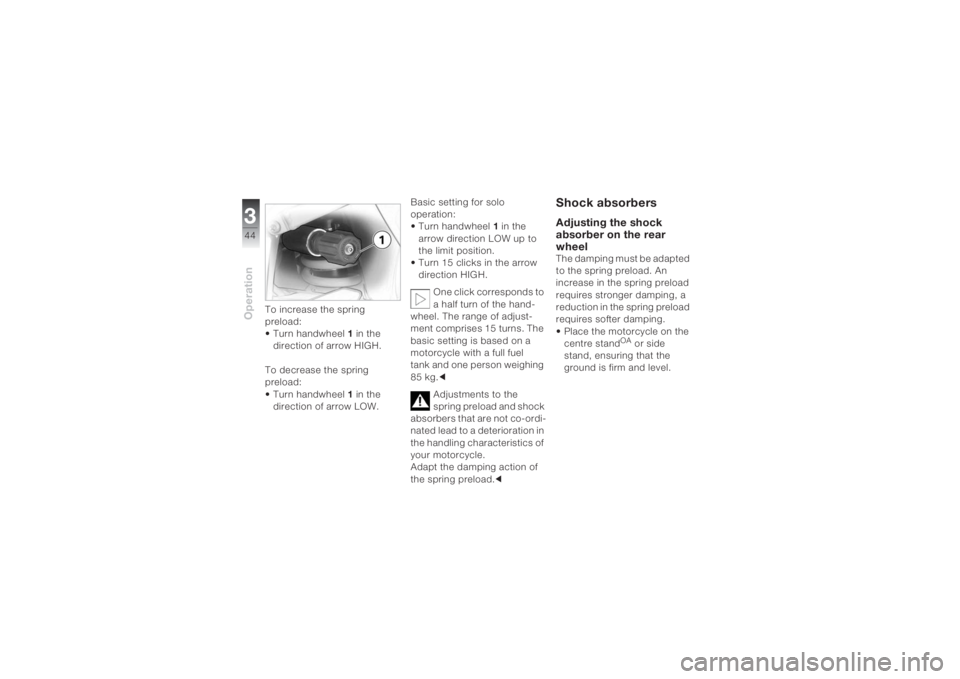
Operation344
To increase the spring
preload:
• Turn handwheel 1 in the
direction of arrow HIGH.
To decrease the spring
preload:
• Turn handwheel 1 in the
direction of arrow LOW.Basic setting for solo
operation:
• Turn handwheel 1 in the
arrow direction LOW up to
the limit position.
• Turn 15 clicks in the arrow
direction HIGH.
One click corresponds to
a half turn of the hand-
wheel. The range of adjust-
ment comprises 15 turns. The
basic setting is based on a
motorcycle with a full fuel
tank and one person weighing
85 kg.c
Adjustments to the
spring preload and shock
absorbers that are not co-ordi-
nated lead to a deterioration in
the handling characteristics of
your motorcycle.
Adapt the damping action of
the spring preload.c
Shock absorbersAdjusting the shock
absorber on the rear
wheelThe damping must be adapted
to the spring preload. An
increase in the spring preload
requires stronger damping, a
reduction in the spring preload
requires softer damping.
• Place the motorcycle on the
centre stand
OA or side
stand, ensuring that the
ground is firm and level.
Page 54 of 162
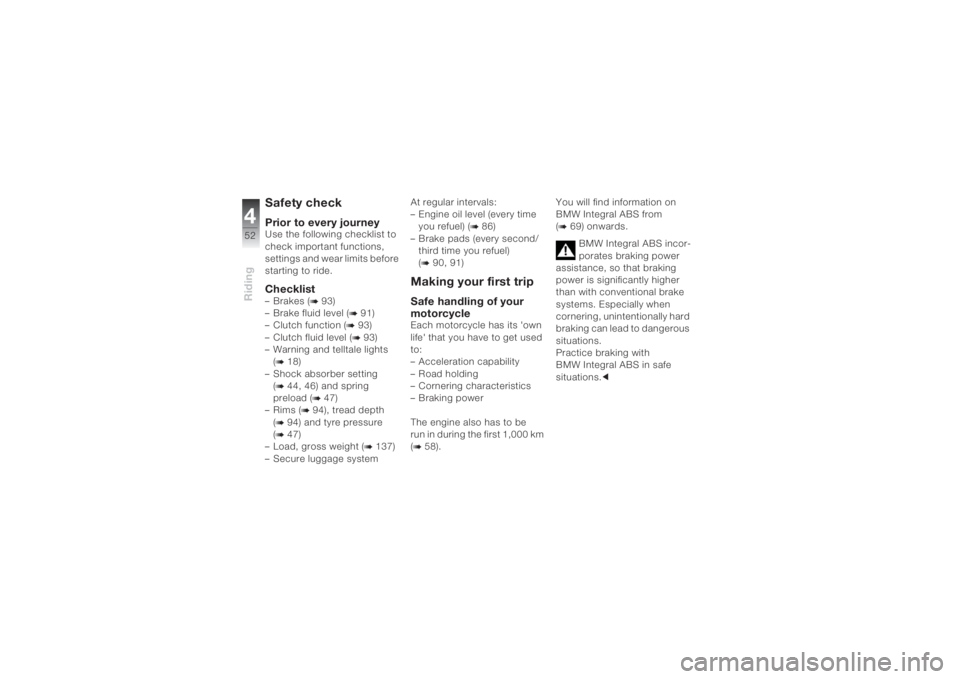
Riding452
Safety checkPrior to every journeyUse the following checklist to
check important functions,
settings and wear limits before
starting to ride. Checklist–Brakes (
b 93)
– Brake fluid level (
b 91)
– Clutch function (b 93)
– Clutch fluid level (b 93)
– Warning and telltale lights
(
b 18)
– Shock absorber setting
(b 44, 46) and spring
preload (
b 47)
–Rims (
b 94), tread depth
(
b 94) and tyre pressure
(b 47)
– Load, gross weight (
b 137)
– Secure luggage systemAt regular intervals:
– Engine oil level (every time
you refuel) (
b 86)
– Brake pads (every second/
third time you refuel)
(
b 90, 91)
Making your first tripSafe handling of your
motorcycleEach motorcycle has its 'own
life' that you have to get used
to:
– Acceleration capability
– Road holding
– Cornering characteristics
–Braking power
The engine also has to be
run in during the first 1,000 km
(b 58).You will find information on
BMW Integral ABS from
(
b 69) onwards.
BMW Integral ABS incor-
porates braking power
assistance, so that braking
power is significantly higher
than with conventional brake
systems. Especially when
cornering, unintentionally hard
braking can lead to dangerous
situations.
Practice braking with
BMW Integral ABS in safe
situations.c
Page 65 of 162
463Riding
Taking the motorcycle
off the side stand
With the ignition switched
off, there is no braking
power assistance; the motor-
cycle can begin to roll.
Especially on inclines, switch
on the ignition and wait for the
ABS self-diagnosis (
b 54).c
• Unlock the ignition lock,
switch on the ignition.
•Wait for the ABS self-
diagnosis.
• From the left, grip the
handlebars with both hands.
• Apply the handbrake.
• Swing your right leg over the
seat, straightening the
motorcycle as you do so.
• Place the motorcycle verti-
cally and balance it out.• Sit down and fold back the
side stand with your left foot.
An extended side stand
can catch on the ground
when the motorcycle is mov-
ing and lead to a fall.
Fold in the side stand before
moving the motorcycle.c
Page 69 of 162
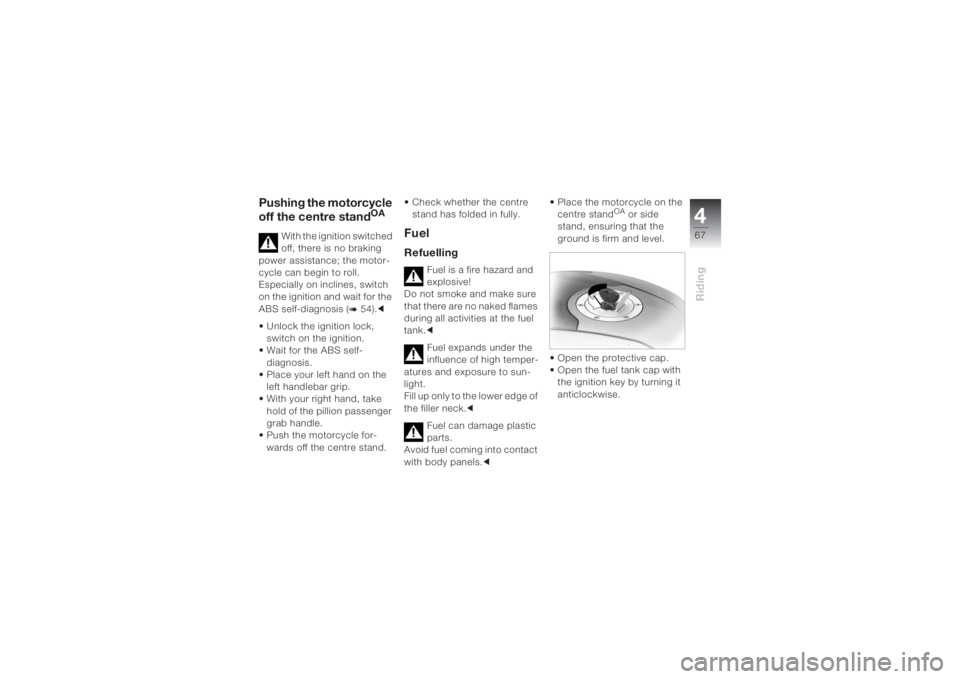
467Riding
Pushing the motorcycle
off the centre stand
OA
With the ignition switched
off, there is no braking
power assistance; the motor-
cycle can begin to roll.
Especially on inclines, switch
on the ignition and wait for the
ABS self-diagnosis (
b 54).c
• Unlock the ignition lock,
switch on the ignition.
•Wait for the ABS self-
diagnosis.
• Place your left hand on the
left handlebar grip.
• With your right hand, take
hold of the pillion passenger
grab handle.
• Push the motorcycle for-
wards off the centre stand.• Check whether the centre
stand has folded in fully.
Fuel Refuelling
Fuel is a fire hazard and
explosive!
Do not smoke and make sure
that there are no naked flames
during all activities at the fuel
tank.c
Fuel expands under the
influence of high temper-
atures and exposure to sun-
light.
Fill up only to the lower edge of
the filler neck.c
Fuel can damage plastic
parts.
Avoid fuel coming into contact
with body panels.c• Place the motorcycle on the
centre stand
OA or side
stand, ensuring that the
ground is firm and level.
• Open the protective cap.
• Open the fuel tank cap with
the ignition key by turning it
anticlockwise.
Page 71 of 162
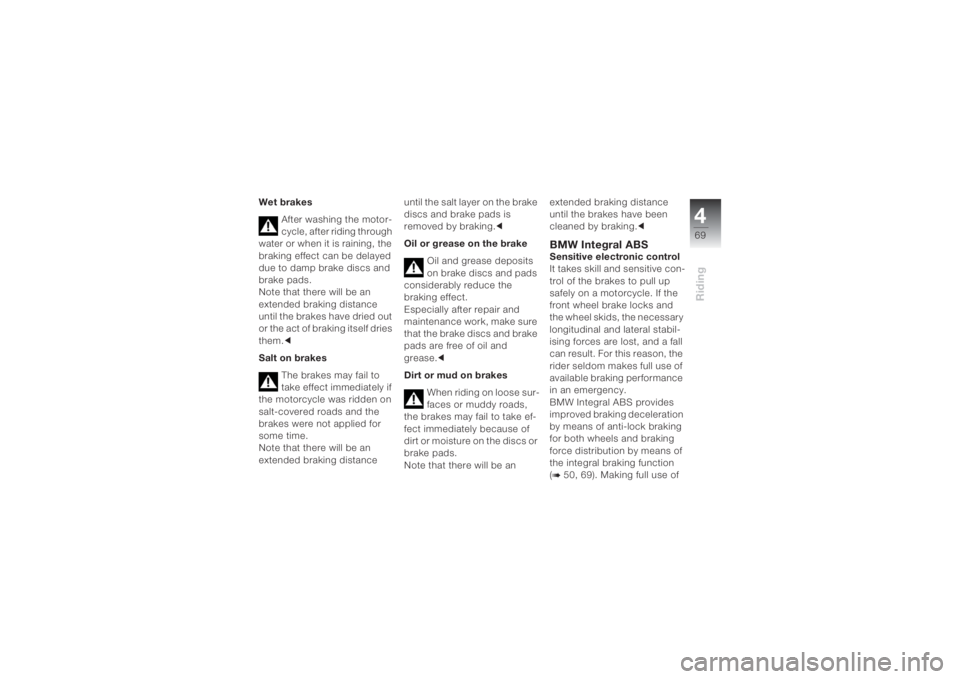
469Riding
Wet brakes
After washing the motor-
cycle, after riding through
water or when it is raining, the
braking effect can be delayed
due to damp brake discs and
brake pads.
Note that there will be an
extended braking distance
until the brakes have dried out
or the act of braking itself dries
them.c
Salt on brakes
The brakes may fail to
take effect immediately if
the motorcycle was ridden on
salt-covered roads and the
brakes were not applied for
some time.
Note that there will be an
extended braking distance until the salt layer on the brake
discs and brake pads is
removed by braking.c
Oil or grease on the brake
Oil and grease deposits
on brake discs and pads
considerably reduce the
braking effect.
Especially after repair and
maintenance work, make sure
that the brake discs and brake
pads are free of oil and
grease.c
Dirt or mud on brakes
When riding on loose sur-
faces or muddy roads,
the brakes may fail to take ef-
fect immediately because of
dirt or moisture on the discs or
brake pads.
Note that there will be an extended braking distance
until the brakes have been
cleaned by braking.c
BMW Integral ABSSensitive electronic control
It takes skill and sensitive con-
trol of the brakes to pull up
safely on a motorcycle. If the
front wheel brake locks and
the wheel skids, the necessary
longitudinal and lateral stabil-
ising forces are lost, and a fall
can result. For this reason, the
rider seldom makes full use of
available braking performance
in an emergency.
BMW Integral ABS provides
improved braking deceleration
by means of anti-lock braking
for both wheels and braking
force distribution by means of
the integral braking function
(b 50, 69). Making full use of
Page 72 of 162
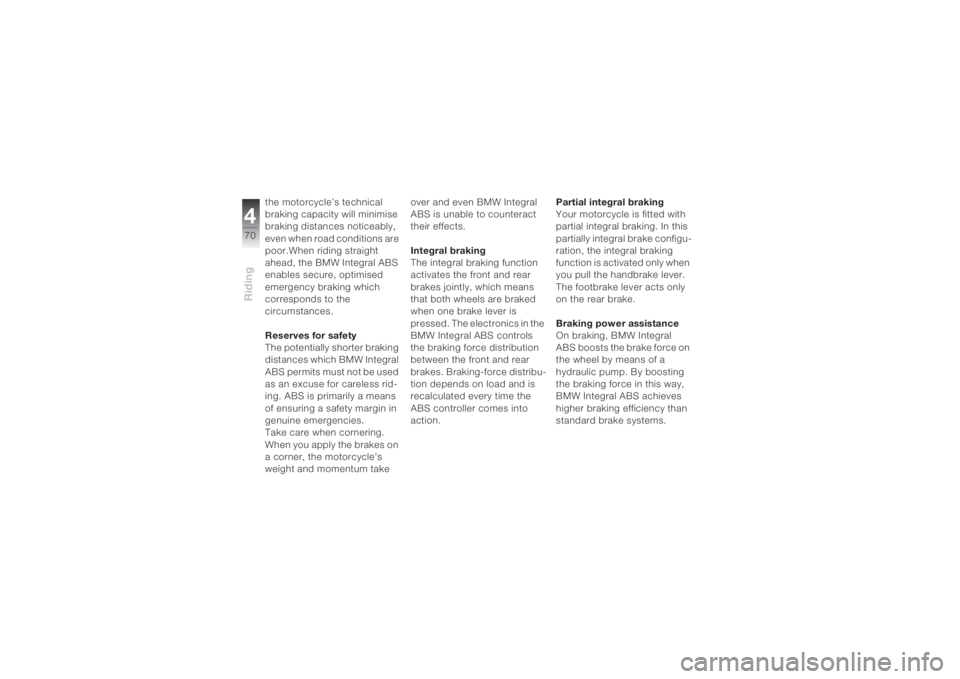
Riding470
the motorcycle’s technical
braking capacity will minimise
braking distances noticeably,
even when road conditions are
poor.When riding straight
ahead, the BMW Integral ABS
enables secure, optimised
emergency braking which
corresponds to the
circumstances.
Reserves for safety
The potentially shorter braking
distances which BMW Integral
ABS permits must not be used
as an excuse for careless rid-
ing. ABS is primarily a means
of ensuring a safety margin in
genuine emergencies.
Take care when cornering.
When you apply the brakes on
a corner, the motorcycle’s
weight and momentum take over and even BMW Integral
ABS is unable to counteract
their effects.
Integral braking
The integral braking function
activates the front and rear
brakes jointly, which means
that both wheels are braked
when one brake lever is
pressed. The electronics in the
BMW Integral ABS controls
the braking force distribution
between the front and rear
brakes. Braking-force distribu-
tion depends on load and is
recalculated every time the
ABS controller comes into
action. Partial integral braking
Your motorcycle is fitted with
partial integral braking. In this
partially integral brake configu-
ration, the integral braking
function is activated only when
you pull the handbrake lever.
The footbrake lever acts only
on the rear brake.
Braking power assistance
On braking, BMW Integral
ABS boosts the brake force on
the wheel by means of a
hydraulic pump. By boosting
the braking force in this way,
BMW Integral ABS achieves
higher braking efficiency than
standard brake systems.